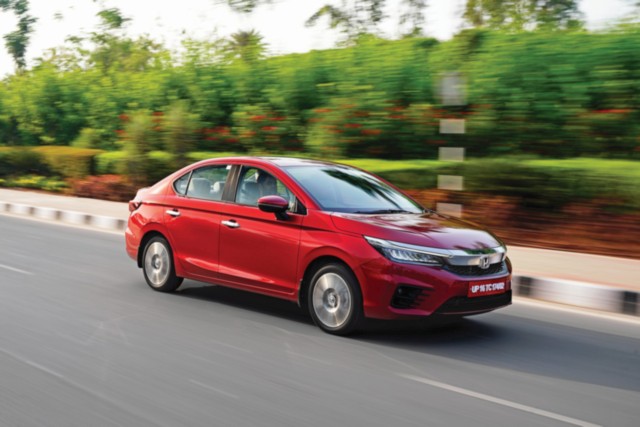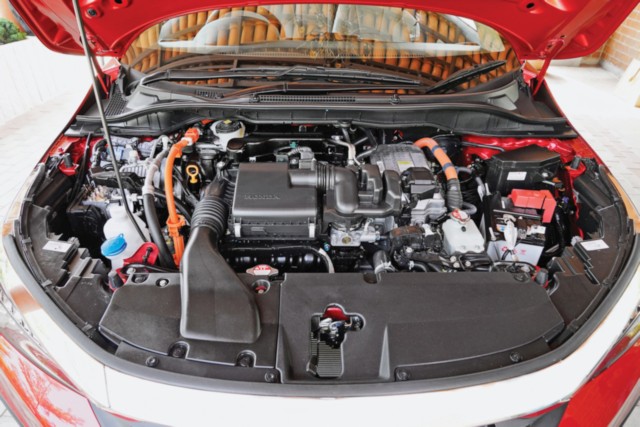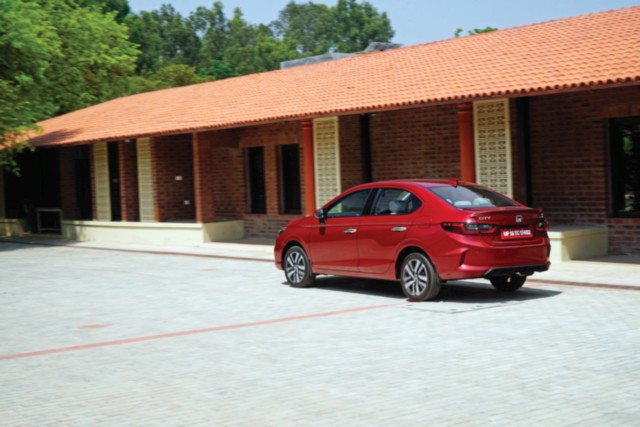
Get going and the Honda City e:HEV is quick to accelerate. Honda’s multi-motor hybrid driveline comprises an 80-kW (109-hp) electric traction motor, a 70-kW (95-hp) motor-generator, a 172.8-volt lithium-ion battery pack, an intelligent power management unit, a 1.5-litre Atkinson-cycle i-VTEC petrol engine with 98 hp and 127 Nm, an electronically controlled continuously variable transmission (e-CVT), and, finally, a wet multi-plate lock-up clutch. More on this complex set-up coming up, so fasten your spectacles.

The e:HEV electric-hybrid system has three driving modes: EV, Hybrid, and Engine. There are also three Regeneration modes during deceleration. The power control unit ensures that it switches among these three driving modes automatically for optimum efficiency, depending on the driving situation. The Honda City e:HEV is primarily driven by the electric motor. The li-ion battery pack is utilised in an optimum zone—and not until maximum or minimum capacity is reached—and is recharged on the go and as soon as it reaches its lower threshold. The engine supports the system with power generation to keep recharging the battery and allowing the car to move on pretty much “EV” and “Hybrid” mode for the most part.
The “Engine” mode kicks in when the accelerator pedal is used beyond a certain point, which brings about the peak system output of 93 kW (126 hp) for maximum acceleration. Here, the engine begins powering the front axle via the single reduction ratio with a drive of approximately 2.74:1, according to the very kind, masked Honda employee speaking to us from Japan over a video conference call. Honda outright refused to divulge the capacity of the lithium-ion battery and the maximum EV range, because, plain and simple, the City e:HEV is not a BEV (Battery Electric Vehicle) and the system is aimed at maximizing motor use and optimizing engine use—within the low to mid bit of the rev-range—to improve efficiency. Of course, the system isn’t meant to be pure EV and that point needs to be driven home any which way. The car also uses an acoustic alert system to warn passers-by of its presence when trundling silently along in electric-only mode.
Thus, while any hybrid car, series or parallel, will run the e-motor as much as possible, it simply won’t do several kilometres at a stretch. For more EV range and even more outstanding efficiency, the plug-in hybrid vehicle (PHEV; larger battery, plug point, sizeable engine and motor, and a lot more weight) is the way to go. However, those do not come cheap. Even so, Honda have a rated fuel economy of 26.5 km/l. Given the right conditions or an open stretch of road, that seems easily achievable. It’s fair to say that with a price of just below Rs 20 lakh for the City e:HEV ZX, it seems like a master stroke from Honda.
The Honda City e:HEV will get from zero to 100 km/h in 10 seconds, making it quicker than the petrol and diesel models; no surprise with 253 Nm coming in from the get-go. The e-CVT and both power plants work well under hard acceleration to give it a more aurally engaging soundtrack as it makes its way up the bands. It’s not meant to be driven pedal-to-the-metal and it prefers cruising along at highway speed, easily achieving more than 20 km/l consistently. Let’s not forget there were two more people in the car along with me, plus luggage, so that’s not bad at all. The whole point of a hybrid is to substantially cut down consumption for a slight premium. Box ticked. The weight penalty, thanks to the minuscule battery pack and electric set-up, is about 125 kilograms more. This City e:HEV weighs 1,280 kg. The boot volume, combining the area above the higher load floor with the under-floor storage space, is 306 litres. The battery pack and control electronics sit underneath as well with a 40-litre fuel-tank allowing a total range of between 650 and 800 km in real-world driving conditions.
The City felt light and nimble, with a light steering feel and a ride that felt a little on the stiffer side. The car held the road well and didn’t leave its line. While the quality of components and the overall fit-and-finish could be better, there is no denying that there is more than adequate space in the rear seats. However, while the driver seat is height-adjustable, the front passenger seat isn’t, making for lesser head-room on account of its higher fixed mounting points. Even so, in this day and age, the City e:HEV is an excellent green, clean, and relatively cheap option for family sedan seekers. We look forward to spending some quality time with it and putting it through our road test.

Need to Know – Honda City e:HEV ZX
Price: Rs 19.50 lakh (ex-showroom)
Engine: 1,498 cc, in-line four, petrol
Max Power: 98 hp @ 5,600-6,400 rpm
Max Torque: 127 Nm @ 4,500-5,000 rpm
Transmission: Electronically controlled, continuously variable, automatic/
wet, multi-plate engine-linked clutch, front-wheel drive
Electric Traction Motor: AC synchronous, permanent magnet
Max Power: 80 kW (109 hp) @ 3,500 rpm
Max Torque: 253 Nm @ 0-3,000 rpm
Electric Generator Motor: AC synchronous, permanent magnet, 70 kW
Peak Combined Output: 93 kW (126 hp)
Battery Pack: 172.8-volt, lithium-ion
Suspension: MacPherson strut front, torsion beam rear
Weight: 1,280 kg




















Leave a Reply